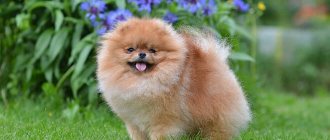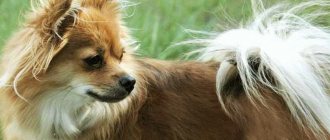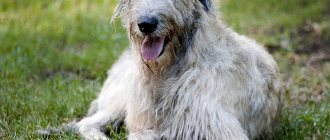a brief description of
- Other names: Volpino Italiano, Cane de Quirinale, Florentine Spitz, Italian Spitz, Florentine Spitz, Italian Spitz, palace dog, Volpino Italiano;
- Height: 25-27 cm;
- Weight: 4.5 – 5.4 kg;
- Color: white, red, fawn;
- Coat: long and lush, straight, hard to the touch, undercoat dense, short;
- Life expectancy: up to 14 years, but sometimes there are individuals that live up to 19-20 years;
- Advantages of the breed: the dogs are friendly and loving, they adore children. Great companions. Very active and playful, regardless of age. They are distinguished by their vigilance - in moments of danger and meeting strangers, they burst into desperate, ringing barks. Tend to protect property.
- Difficulties: by nature, these are independent dogs, making their own decisions, with a fair amount of stubbornness. Dogs shed heavily, leaving balls of long hair everywhere. They experience separation from their owner acutely and painfully.
- Price: negotiable, due to the rarity of the breed.
Character traits
A cheerful dog is always ready to play.
Spitz is a playful, sociable dog. Dogs become attached to the owner, but do not show intrusiveness. Toys help to endure short-term separation from the owner.
Volpino are considered excellent watchdogs, but if you do not train the puppy from childhood, he will bark over trifles.
Dogs remain playful into old age. Animals in sports, such as agility or Frisbee, achieve good results.
Italians are non-aggressive with other pets, treat children well, and will never harm a younger family member.
Important! Although the dog is considered friendly, children must understand that the animal is not a toy and must be handled with care.
Origin story
When literally translated, the name of this indoor and decorative breed sounds like Italian fox . Playful and energetic , the Volpino Italiano is virtually indistinguishable from the white Mini Spitz . And this is not surprising, since all Spitz have common roots, and originated from the German Spitz.
The first images of the palace dog, or Florentine Spitz, date back to the 9th century AD. e. During archaeological excavations on the territory of present-day Florence, many ceramic vases with drawings of dogs of original appearance, similar to Spitz dogs, were discovered.
Widespread on the Apennine Peninsula, the breed has enjoyed great popularity at all times of its existence. Especially in rural areas, where dogs were used as guards. An ancient legend says that a Volpino-Italian couple drove away a pack of wolves with a ringing bark, and thereby saved the lives of a large herd of cows.
The breed's popularity peaked at the end of the 14th and beginning of the 15th centuries. Italian Spitz dogs of that period were in the care of the local nobility. Pampered, dressed in expensive outfits with jewelry made of precious stones, they were truly considered palace dogs. for the Volpino Italiano breed was so high that a simple villager could not afford to own a fluffy bell for his own pleasure .
The most famous owner of the Florentine Spitz was Michelangelo. The dog took an active part in the artist's painting of the walls of the Sistine Chapel. Great Britain owes the appearance of Volpino-Italian to Queen Victoria, who brought a pair of snow-white specimens from Europe to her palace.
Purpose of the breed
Initially, the Florentine Spitz was bred for protection and to serve as a companion dog. The first official marks of the birth of litters in the stud books of Italy date back to 1901. But over the next fifty years, the popularity of the breed began to decline rapidly, to the point that by the beginning of the 20th century, the Italian Spitz was listed in the Red Book .
Having come to their senses, Italian dog handlers set about restoring the breed, but the dogs never achieved much popularity due to the emergence of new exterior breeds. According to statistics, by the beginning of 2000 there were no more than 2,000 individuals in the world .
Today, the Volpino Italiano serves as an indoor and decorative dog breed , participating in international dog shows and simply delighting its owners. But the growth in popularity of the breed has not been particularly noted.
Breed standard
Volpino Italiano is a decorative miniature dog. The small narrow muzzle gives it a resemblance to a fox, as the name suggests. Translated from Italian, “volpe” means fox.
The following is a description of the main characteristics that determine the breed standard. Any deviation is considered grounds for rejection:
The presented photo of a Volpino Italiano demonstrates the accepted breed standard.
Disqualifying signs, in the presence of which Volpino Italiano is not allowed for breeding and participation in exhibitions and demonstration shows: Light color of the iris of the eyes is also a disqualifying defect of the Italian Spitz.
Character
Loyal and responsible dogs have a playful temperament with a high degree of sociability , even with strangers. But for his family, Volpino Italiano is a sensitive guard , loudly alerting others about impending danger or suspicious visitors.
Aggression is alien to the naturally good-natured and inquisitive Italian Spitz . Dogs prefer noisy outdoor games, especially with small children . They tend to get along with other pets, birds or rodents living with dogs under the same roof. And Florentines are very loyal to neighboring representatives of the animal world.
Volpino takes the promenade for granted, and his behavior on the street depends on the purpose of the walk. The owner uses a leash in extreme cases . Only in unfamiliar places should the dog be put on a leash, since the Volpino is not prone to running away or fighting. But when a conflict is initiated, this small animal gives a complete rebuff with great dignity , regardless of the size of the attacker.
Exterior of the breed
A photo of an Italian Spitz shows a small dog with fluffy fur. The dog is harmoniously built, its height at the withers is almost equal to the length of the body. Males are slightly larger than females and reach a height of 27-30 centimeters. The dog's back is straight and strong, the croup and withers are slightly raised above the general line. The Spitz's tail is long, curled over the back in a perky ring and decorated with long, thick hair. The head is wedge-shaped with a short, sharp muzzle.
The ears are erect and triangular. The dog's nose is large and usually black. In some cases, a brownish color is allowed. The Italian Spitz's lips are full and well defined.
The pet's eyes are medium-sized, lively, cheerful, dark brown.
The animal has strong jaws with strong white teeth.
The dog's coat is thick and straight. The pet's fur is long over the entire surface of the body; short fur predominates on the head, muzzle and ears.
The dog's color can range from snow-white to reddish. Fawn and red colors are allowed.
Choosing a puppy
from a breed kennel is considered a reliable and safe purchase of a puppy . Without a doubt, no breeder guarantees a 100% future champion or a puppy completely free of breed predispositions to certain diseases, but at the time of sale such puppies are absolutely healthy .
So-called culls in breeding plants are an extremely rare occurrence, since dog handlers carefully calculate the mating, carefully studying each line of the parents. Here the buyer will be provided with a complete package of documents:
- veterinary passport with dates of vaccinations, sealed by the veterinary clinic;
- internal pedigree, if the puppy is purchased from a European nursery, or a domestic puppy;
- parental health certificates.
The nursery will provide full advice on feeding a small Volpino and the nuances of education, as well as how to initially teach the dog to go to the toilet in a tray and measure the temperature.
When choosing a puppy, you should pay attention to the color of the nose - it should be dark . The coat should be fluffy and the belly should not be swollen. Since the breed is considered one of the healthiest, a bloated belly indicates the presence of worms in the intestines. All babies of the litter should be playful, active, fearless and very curious .
Due to the rarity of Volpino Italiano dogs, puppies have different prices, and the price is set by breeders based on the investment in mating . As a rule, the price for puppies of this breed is negotiable.
How to choose a puppy
An excellent breed of Italian Spitz is indicated, first of all, by the peculiarity of the dog’s physique. First of all, this concerns the proportions of the dog’s skull. It should be slightly elongated in both width and length. The forehead and muzzle should form a right angle, the lower jaw should be pronounced. There should be no skin folds in the corners of the mouth.
Something to keep in mind when purchasing a pet. That the slightest deviation from the norm is considered a flaw. Deviations from the norm include light-colored eyes and nose, a limp tail, or uneven coloring. Long legs with unrounded paws are also a fault. Lethargic, inactive puppies should also be a concern. This behavior may indicate that the animal is unwell. Little Spitz are very temperamental and friendly creatures. Leadership character can be evidenced by the intention to get out from under the hand of a person who is lightly pressing the dog to the floor. A weak-willed puppy will surrender to the mercy of the winner, while the future leader is more likely to show aggression and perseverance to achieve freedom.
Nicknames and names
The official names of dogs of this breed are pompous, consisting of several words, and include a prefix - the name of the kennel. More often, funny little puppies are given original pet names:
- Atom;
- Aqua;
- Bagel;
- Barbie;
- Bear;
- Bullet;
- Rondo;
- Fanta;
- Yula;
- Hippie.
Short, sonorous and easy to pronounce, names fully reflect the character or appearance of the dog.
Care and maintenance
The Volpino Italiano breed of small dogs is considered ideal for apartment living . Florentines tolerate enclosure conditions well if a large amount of time is devoted to them - they often communicate with the dogs and regularly take them for walks.
It is important to allocate a place for the dog in the apartment - a cozy corner, without drafts and direct sun, where the dog will feel “at ease”, without excess attention, comfortable and cozy.
Pets need regular but simple care for their coat, eyes, ears, claws and dental system. Dogs have strong teeth, and tartar rarely forms. Ears are cleaned regularly. Indoor dogs' claws grow faster than those who live in private homes with accessible walking, and they have to be cut. Eyes are examined daily . Caring for long, coarse hair involves frequent brushing. Especially during the shedding period, when dogs need to be brushed daily.
Important! Grooming Volpino Italiano dogs is strictly prohibited, as is frequent bathing with the use of cosmetics, due to the immediate change in the structure of the guard hair and drying out of the surface layer of the dog's skin.
Health and heredity
Volpino has good health and excellent immunity . Dogs are not predisposed to certain types of diseases. Hereditary complications manifest themselves in cryptorchidism - the absence of one or both testes, and distichiasis - pathological abnormal growth of eyelashes.
Diseases of the cardiovascular system and visual organs occur in dogs only as age-related changes. The strength of health is quite explainable by the way of life of our ancestors.
After the palace coups ended, the Florentines lived on farms. The former palace dogs were not particularly pampered, and only healthy individuals survived, passing on healthy genes from generation to generation.
Catering
Unlike other indoor dog breeds, Volpino is absolutely not picky about food , as they have a strong gastric system. But breeders still recommend feeding your pets with ready-made dry food, especially puppies, since the food contains all the useful ingredients and components of the vitamin and mineral complex necessary for the growth and development of a young dog. Each owner selects the manufacturer and brand of food for his dog individually.
Diet
Spitz are unpretentious in food; the dog can be fed natural food or premium dry and wet food.
The source of energy is lean meat, and offal is occasionally provided. About once a week they feed them sea fish.
Note! Volpino Italiano's diet should also include cereals (rice and buckwheat), low-fat cottage cheese and kefir, and vegetables. Once a week they give a chicken or quail egg.
The dog is fed an apple as a treat.
Education and training
Severity or harshness is unacceptable in raising a Florentine Spitz . You need to be persistent, and a naturally intelligent dog will quickly understand what is required of it. You especially need to be patient when your dog is being trained to go to the toilet outside. Abundant rewards with treats and affectionate treatment significantly speed up the process.
The puppies are taught independently, practicing the basic commands of the general training course.
It should be remembered that a sedentary lifestyle is detrimental to the health of an active being. Dogs are affectionate, and prolonged absence from their owner can lead to depression and aggressive behavior.
Advantages and disadvantages
Strong and unpretentious, Volpino easily adapts to any living conditions if the owner is nearby. Moreover, dogs are not likely to run away from home due to their deep love for the owner. Representatives of the breed completely lack hunting instincts.
Volpino, with a loud and ringing bark, are considered good warning signs . They are distrustful of strangers, but do not express aggression , barking at strangers for a long time. The only job for the Florentine Spitz today is as a companion dog . You can always take a small dog with you, and it doesn’t matter whether the owner is going to the country or on a trip.
Story
Speaking of how much Volpino Italiano costs, get ready to shell out around 50 thousand rubles. This breed has very ancient roots; images of these dogs were noted around the 9th century BC. Peasants loved dogs for qualities such as attention and vigilance. Representatives of the breed promptly warned with a loud voice about the approach of strangers.
It is described that the world-famous Michelangelo had a pet of this particular breed.
The breed was officially recognized only in 1901. For obvious reasons, interest in dogs began to gradually fade away, and these dogs practically disappeared.
In 1965, only five dogs of this breed were noted in the stud book. In 1985, cynologists in Italy decided to do everything possible to preserve these dogs. They selected strong and healthy dogs that were preserved in the villages. The population was saved.
Unfortunately, there are currently approximately 2,000 representatives of the breed worldwide. Interest in these amazing animals is being revived again, however, this is happening very slowly.
Reviews
Julia:
Affectionate, funny, playful, cheerful. I don't have enough epithets to describe my happiness. She is always happy when she gets home from work and is very artistic. He just suffers if he doesn’t show me to everyone on a walk. The downsides are the ubiquitous wool and the love for my cosmetics. You can't leave your bag open - he steals candy and lipstick. And yet – the extremely high cost of a puppy.
Glory:
Florentines have well-developed facial expressions, and they know how to smile. My dog gets along with us in an ordinary two-room apartment. He is friends with his four-year-old son, they understand each other perfectly and know how to negotiate. They steal cheese and sausage for two from the refrigerator. If a mother scolds her son, the dog fiercely defends his friend. He considers me a leader, and has never “raised” his voice in my direction.
If you have more information on the Volpino Italiano breed, moreover, if you are the owner of this amazing creature and you have something to tell about the breed, you can leave comments at the bottom of the article. We will always welcome your stories, advice and impressions.
Share
Leave a review
Add a comment Cancel reply
- Evgeniya
I am the happy owner of 2 wonderful Volpino. Each of them has their own character, but they are united by their boundless devotion to their family. I would like the breed to become more popular in Russia, as it was before the revolution. Russian nobles often visited Italy and undoubtedly took many representatives of this breed from there. Let us recall Serov’s painting “Portrait of Zinaida Yusupova” or Chekhov’s story “The Lady with the Dog”. I am sure that this particular breed was meant both in painting and in literature.
Psychological picture
Small stature is compensated by strong character. She is loyal to her owners and, interestingly, has a protective instinct. Despite its small stature, it is an excellent watchdog - it is suspicious of strangers and speaks up without hesitation.
Of all the small-sized Spitz varieties, he is perhaps one of the most active.
Volpino is a dog with amazing intelligence; it is noteworthy that the dogs brought from Italy began to understand Russian speech addressed to them literally after two months.
Volpino are very curious and playful, they can accompany their owner or mistress all day long. Separation makes them unhappy; they do not like to be alone; they need company. They learn the habits of their owners and try to adapt to them. He is very affectionate to his owner, although he has some independence.
She does not chew furniture, does not enter into conflicts with other animals, and does not run away while walking.











